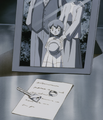Amber (anime)
| の | This article is missing information on this character's English voice actor. You can help by adding this information. |
Amber (Japanese: アイ I) was the daughter of Dr. Fuji, who died while she was still a child. She first appeared in The Birth of Mewtwo radio drama, released in CD format exclusively in Japan, and then in The Uncut Story of Mewtwo's Origin short, which was added to the beginning of Mewtwo Strikes Back in all television airings in Japan and in the Japanese home video releases from the third one onward.
Dr. Fuji's despair at losing his daughter led him to dedicate most of his life to research into cloning, with the belief that he would be able to create a clone of Amber if he discovered the secrets of recreating life. This led Giovanni to fund him, with the condition that he would also clone Mew, creating Mewtwo.
Both Mew and Amber were successfully cloned, and Amber's clone was named Ambertwo (Japanese: アイツー Itwo). While they were both growing inside test tubes on New Island, Mewtwo communicated with Ambertwo telepathically. Unfortunately for Fuji, Mewtwo's genetic makeup as a Pokémon and sheer force of power (and tears in the English dub) kept it alive while Ambertwo died. Fuji was heartbroken, but continued his work on Mewtwo with the hope that another try at cloning Amber would be more successful.
However, any hopes of seeing her actually alive died alongside Fuji, as Mewtwo destroyed the laboratory on New Island.
Voice actors
| ||||||||||||
Trivia
- Amber's Japanese name is directly based on the English first-person singular personal pronoun I, as explained by Takeshi Shudō in a blog post of his authority.[1]
- In the early stages of the radio drama's production, Amber was originally referred to as Me, but was later renamed to I as Shudō felt that it connotes a stronger assertion of self-existence. The name Me was later used on a different character.
- If one counts the radio drama and The Uncut Story of Mewtwo's Origin, Amber is the first human to be seen dying in the Pokémon anime.
See also
References

|
This article is part of Project Anime, a Bulbapedia project that covers all aspects of Pokémon animation. |


